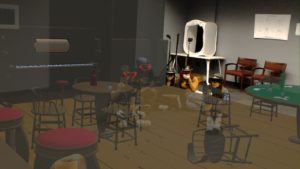Transforming Language Learning with Augmented Reality
Guest post by Iva S. Youkilis, Teaching Professor in Italian, Department of Romance Languages and Literatures, Washington University in St. Louis.
According to Chomsky (EduKitchen, 2023), students are engaged and willing to learn if a class is interesting to them. Thus, unique, creative educational experiences create opportunities for diverse forms of engagement in and outside the classroom. As someone who has embraced technology-enabled innovations, given their potential in language classrooms, I have been experimenting with how to improve and diversify my class and lesson design by integrating digital tools. After completing a course on Post-Pandemic Language Teaching through Online Language Teaching (OLT) initiative at Michigan State University’s Center for Language Teaching Advancement (CeLTA), I was determined to capitalize on the capabilities presented by the current technological advancements, appreciating how these technological and cultural changes could benefit my language teaching practices.
One of the examples was integrating AR technology in my Advanced Italian class at Washington University in St. Louis. Last semester, in that class, we studied games as a form of social interaction from a historical perspective: in contrast to the contemporary fear in Italy of the adverse effects of video game play. I arranged a visit to the Earth and Planetary Sciences Lab, where we used Augmented Reality (AR) technology to explore a room-size saloon scene with HoloLenses. The location was a free 3D model downloaded from the Sketchfab website. A lab staff scientist blew it up to almost exactly the size of the laboratory room, creating a more realistic experience. As we walked around the deserted space, which appeared to have been hastily vacated after a game like a poker, we were able to clearly see the playing cards and identify the winner and losers. The room was in disarray, with scattered chairs, spilled wine, and tipped-over glasses and bottles. We also found an open safe behind the bar and examined the sheet music on the piano. All along, we tried to guess what might have happened and where the saloon might have existed, given the architecture of the walls. This immersive and interactive experience was not only fun but it helped students refine their expression, as they used more sophisticated syntactic structures such as hypothetical sentences and subjunctives.
The use of augmented reality (AR), apart from being novel and engaging, can be beneficial to cognitive development in language acquisition. Che et al. (2010) note that Vygotsky’s and Piaget’s cognitive and psychological theories of learning and development emphasize the importance of stress, challenge, and disequilibrium in learning. Piaget’s theory of cognition includes a stage known as disequilibrium, which refers to a state of cognitive conflict or imbalance that is caused when individuals encounter new information (Kibler, 2011). The author maintains that this conflict is necessary for learning and intellectual growth, as it motivates individuals to resolve the conflict by creating new mental structures or modifying existing ones. Using Augmented Reality (AR) with relevant superimposed digital images challenged students to negotiate and make meaning because of novel immersive, and interactive space.
Moreover, AR inspired students to independently explore and try out the language to communicate their thoughts effectively, not just in Italian but also with the purpose of exchanging ideas. As a result, students left the lab feeling more confident in their ability to use the languages and excitedly shared their perceived improvement in Italian. One of the students said, “It encouraged us to use new vocabulary and navigate topics of conversation different from what we typically used in the classroom. We not only practiced Italian but had fun doing it.”
Similarly, AR technology has the potential to support the use of heuristics to aid in language learning. Clancey (1985), while discussing Study Abroad experiences, maintained that heuristics could be particularly useful in situations where individuals have a lot of experience and knowledge about the task at hand and are able to apply that relevant knowledge in the problem-solving process intuitively. Within the created AR learning environment, students had the necessary vocabulary, grammatical structures, and understanding of game mechanics in a social context; their task was to explain and draw conclusions given the digital scenario. As a result, when they entered the virtual space that appeared to be a real-world setting, students used their existing knowledge to make connections with the new situation, creating complex sentences and engaging in dynamic and stimulating dialogue.
Using AR in my language teaching has provided effective and engaging experiences that function as added activities for breaking up classroom routines and challenging my students to engage in multiple means of expression and action. In my case, students have welcomed these opportunities and have been open to repeating them. However, as always, there are some challenges associated with utilizing AR. Firstly, there is a cost involved in using the lab and compensating for the technician’s assistance, in addition to the cost of owning HoloLens. Secondly, HoloLens can be quite heavy and cumbersome, causing headaches and physical discomfort if worn for a prolonged amount of time. As a solution, investing in more wearable equipment, such as Magically, may be necessary, but this, too, incurs additional costs. Lastly, teachers need to have curiosity and adequate media literacy understanding to guide students to develop their language skills through motivating activities enhanced by integrating emerging technologies.
References
Che, S. M., Spearman, M., & Manizade, A. (2010). Constructive disequilibrium: Cognitive and emotional development through dissonant experiences in less familiar destinations. In The handbook of practice and research in study abroad (pp. 121-138). Routledge.
Clancey, W. J. (1985). Heuristic classification. Artificial intelligence, 27(3), 289-350.
EduKitchen. (2023, January 20). Chomsky on ChatGPT, education, Russia and the unvaccinated [Video]. YouTube.
Kibler, J. (2011). Accommodations, Piagetian. Encyclopedia of Child Behavior and Development. Boston (MA): Springer US, 17-18.










